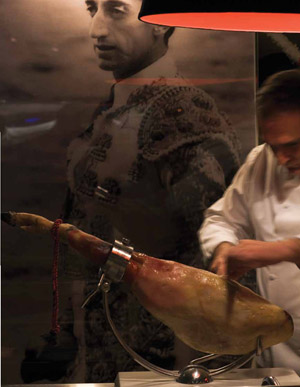A GASTRONOMICAL CIRCUS
FOUR MONTHS AFTERSAM NAZARIAN’S SLS Hotel at Beverly Hills opened in November 2008, the Los Angeles Times proclaimed its culinary heart the top-rated restaurant in all of L.A. “Los Angeles has never seen anything remotely like this,” declared the restaurant critic S. Irene Virbila. She described it as “Fellini-esque, a gastronomical circus, a flirtation with the flavours and soul of Spain.”
Nazarian, the 33-year-old owner and CEO of SBE (short for Sammy Boy Entertainment), had yet another hit on his hands. This time it was a high-end hotel to top his line-up of Katsuya sushi emporiums and super-trendy L.A. nightspots like Area, Foxtail and Hyde Lounge. In fact, because he started the SLS project even before launching his clubs and restaurants over the past five years, Nazarian considers himself “a hotel guy” first rather than a nightclub or restaurant guy. But Renaissance man might describe him best.
For help in bringing his dream hotel to life, Nazarian enlisted an international team of hospitality heavyweights including French icon Philippe Starck for the design, Spanish-born celebrity chef José
Andrés for the food and Starwood Hotels & Resorts Worldwide for management under the Luxury Collection banner. Despite setbacks and sluggish occupancy rates due to the economic crisis, the SLS Beverly Hills is still poised to be the flagship in Navarian’s fledgling line of SLS-branded hotels, soon to include Nazarian’s revamped Ritz Plaza in South Beach (2010) and Sahara Hotel &
Casino in Las Vegas (2011).
MAIN COURSE
True to plan, life at the first SLS revolves largely around the signature restaurant. Called the Bazaar by José Andrés, the sprawling 1,400-square-meter space serves as a lobby as well, taking up the lion’s share of the ground floor at the former Le Méridien at Beverly Hills. Nazarian says he drew inspiration for its concept from the piazzas of Italy. He wanted not one destination but a collection of free-flowing destinations where the Hollywood A-list and guests of the hotel could interact with each other and the environment, according to their shifting moods and whims.
Guests sit on either sofas or chairs, with their own party or at a communal table. They lounge on banquettes, pull up to the counter or merge with the impromptu cocktail party that often forms in the open space at Bar Centro. They order billowing liquid nitrogen, chilled caipirinhas, caviar cones, cotton-candy foie gras and other astonishing savouries from roving carts. They nibble on sweets while watching bakers and candymakers at work behind glass at the Patisserie. They can have their caricature drawn, fortune told or wander about, shopping or simply marveling at the objects encased in museum-like vitrines curated by Murray Moss and Franklin Getchell, owners of Manhattan’s retail design temple Moss.
The Bazaar’s two main dining areas, Rojo and Blanca, plus the chef’s tasting room SAAM, feature avant-garde and traditional tapas created by Andrés, who partnered with Nazarian and Starck to create the Bazaar in 2007. The chef’s credentials rival his partners’. Born in Mieres, Spain in 1969, he studied the culinary arts in Barcelona, then worked at several Michelinstarred restaurants, including today’s epicentre of global avantgarde cuisine, El Bulli. Andrés’ company THINKfoodGROUP is behind some of the most widely-acclaimed restaurants in Washington, D.C., including the tapas-themed Jaleo and the now legendary prix-fixe Minibar by José Andrés at Café Atlántico (which requires reservations at least a month in advance). The New York Times called him the “boy wonder of culinary Washington.” In 2009, the James Beard Foundation nominated the Bazaar for the Best New Restaurant and Restaurant Design awards, and Esquire magazine named it Best New Restaurant of the Year.
CHEEKY MONKEY
Perhaps only one designer could hold his own in collaborating with powerhouses like Nazarian and Andrés: Philippe Starck, who at the age of 60 can’t seem to outgrow his role as the ‘enfant terrible’ of modern hotel design. Early in 2007, Starck contributed to the redesign of Le Meurice in his hometown of Paris and then signed an exclusive 15-year contract with Nazarian to design the new line of SLS hotels. In agreement on the basic SLS concept and goals, Starck, like Andrés, had free rein from Nazarian for the California flagship. The food-focused Bazaar would serve as the main
lobby, but hotel guests would also have a reception lobby with generous indoor and outdoor lounge areas and a restaurant ripe for social interaction. Andrés would oversee the menus for
both lobbies as well as for catering, in-room dining and service at the rooftop pool.
Starck’s approach to design appeals to a young-atheart, educated, moneyed clientele. Like Andrés, he strikes a balance between reverence and irreverence in deconstructing and then reconstructing traditional elements from the past. Innovation, technology, visual jokes, even surprise play big parts in the success of both of their careers. The SLS logo encapsulates this shared sensibility. At first glance, the image appears to be a traditional chandelier. But a closer look reveals monkeys perched between the lights. They hold an old-fashioned mirror, bell, goblet and fork apparently looted from formal settings just out of sight.
Careful observers might discover one tiny monkey painted on the back wall of their closet. Starck also set billiards tables in the shared open space on every guest-room floor and, tongue firmly in cheek, lined the elevators with a photographed cast of life-size lift riders. A sliding mirrored wall opens the bathroom to the bedroom in every guest room. And everyone loves their large-screen TV, hidden behind another full-length panel of mirror which is invisible until you turn it on and watch it right through the mirror.


